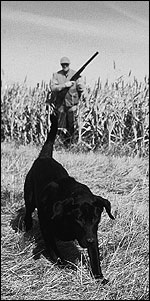When protecting the health of your dog, it's best to know the facts.
By Tom Holcomb, ,DVM
(Question)
Dr. Holcomb, I have been reading as much as possible about the West Nile Virus here in Iowa. I am wondering about the possibility of my retrievers contracting the virus as they do their job of retrieving pheasants. Because WNV is a blood-borne pathogen, the probability of dogs having blood-to-blood contact is very high. Any information on this would be greatly appreciated. --BW
(Answer) Thanks for asking this question. There has been so much publicity about this disease that I really feel the need to "get off" on the whole thing. I'm tired of hearing about it! This virus causes clinical disease only in horses consistently and occasionally in people. The virus may invade other animals including dogs via a mosquito bite with no clinical disease produced.
Eastern, Western and St. Louis strains of encephalitis virus have a similar epidemiology-epizology as West Nile Virus and we don't seem to get concerned by the fact that these viruses are indeed carried by pheasants and other game birds that we have handled for years with no apparent ill effects.
Another thing I don't understand is why a vaccine company can come up with a vaccine for horses so quickly but not be able to produce one for humans. The same thing happened with Lyme disease. I don't understand how people in our society can be so concerned about this disease when HIV and other sexually transmitted diseases are spread through our population with seeming disregard. We need to heed the advice of the Trojan company and "wrap that rascal" rather than worrying about contact with the blood of a dead bird.
 To keep your dog out in the field, make sure you keep him healthy with regular visits to the vet. |
Here is another one for you to think about as you are out in the wilds contacting the various critters that live there. Recently a young man here in Iowa died of rabies. This was the first case of rabies in a human in Iowa in the last 50 years. While authorities are awaiting the results of viral typing to help identify the source of exposure at this time suspicion is that the infection was of bat origin. While this is not a common disease it does have a high mortality rate and behooves all of us to be cautious so we do not expose ourselves to a bite or scratch wounding by mammals at large.
(Question) Human nutrition is expressed in calories, with percentages of fats, proteins, carbohydrates and fiber comprising those calories. While trying to adjust the diet of my overweight golden retriever, I see dog food packages only show minimum and maximum percentages and no caloric values. What are or where can I find the caloric and nutritional guidelines for dogs in "human terms"? --GG
(Answer) Nutritional analyses are expressed in the same terms whether the species involved are dogs, humans or any other animal. I think what you are looking for is the nutritional requirements of the dog. These certainly differ from those of the human species and every other species. Fat is fat and protein is protein. Dog food sacks list ingredients and percent content of fat, protein, calcium, phosphorus, fiber, and moisture.
They also contain feeding guidelines and an 800 number to call for more information. If your intent is to go through the steps of obtaining the caloric density of the food and then determining the caloric needs of your dog to then calculate the amount of food to feed your dog, you are wasting your time and merely going through an academic exercise that simply belongs in the classroom.
What you need to know is that overfeeding and lack of exercise lead to fat dogs. I would suggest that you cut down on the dog's total ration and increase her activity. A simple guideline is to cut the total ration by one-third. Also, cut out any treats you may be giving her.
(Question) My daughter and her husband have a seven-year-old Chesapeake that was diagnosed five months ago with diabetes. He is on an insulin regimen (two shots daily). In the last week they have noticed cloudiness on both of his corneas and he seems to be losing his eyesight. What would you recommend? Can anything be done for this dog? --GS
(Answer) Cataracts are a common consequence of diabetes in the dog. As in humans, dogs can be operated on for removal of cataracts. I think there is even a new technique available that makes the procedure simpler and more effective. Also, strict adherence to your veterinarian's treatment plan is important. These dogs get along well if diet is controlled, insulin given accurately and periodic glucose curves run to monitor the adequacy of the medication.
SEND YOUR QUESTIONS AND COMMENTS to Dr. Tom Holcomb at h1holco@attglobal.net.






